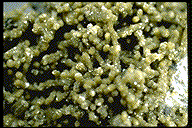 THE
MINERAL MACPHERSONITE
THE
MINERAL MACPHERSONITE
 THE
MINERAL MACPHERSONITE
THE
MINERAL MACPHERSONITE- Chemistry: Pb4SO4(CO3) 2(OH)2 , Lead Sulfate Carbonate Hydroxide.
- Class: Carbonates
- Uses: Only as mineral specimens.
Specimens
Macphersonite is named for a mineralogist at the Royal Scottish Museum, namely Harry Gordon Macpherson.
It was named as recently as 1984.
Macphersonite is a cousin of the more well known although still scarce
leadhillite.
The two minerals are dimorphs.
A dimorph is a mineral that shares the exact same chemistry with another mineral, but their structures are different (di in latin means two and morph in latin means shape).
Typically the different structures make the symmetries different as well.
In this case, macphersonite is an orthorhombic
mineral while leadhillite is
monoclinic in symmetry.
There actually is another mineral that has the same chemistry and a different structure from these two.
The mineral is called
PHYSICAL CHARACTERISTICS:
- Color is colorless, white, amber or brownish.
- Luster is adamantine to resinous.
- Transparency: Crystals are transparent to translucent.
- Crystal System is orthorhombic; 2 m m
- Crystal Habits include tabular or pseudohexagonal crystals.
- Cleavage is perfect in one direction.
- Fracture is uneven.
- Hardness is 2.5 - 3
- Specific Gravity is 6.5 - 6.6 (very heavy for a translucent mineral)
- Streak is white.
- Other Characteristics Some specimens are
fluorescent yellow. - Associated Minerals include leadhillite, galena, anglesite, linarite and cerussite.
- Notable Occurrences include the type localities of
Leadhills, Lanarkshire , Strathclyde, Scotland and Aregentolle Mine, Saint-Prix, Saone-et-Loire, France and at least one specimen at Moon Anchor Mine, Maricopa County, Arizona. - Best Field Indicators: Crystal habit, color, luster, density, fluorescence and locality.








